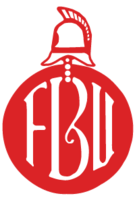Fire Brigades Union
 |
|
| Motto | The professional voice of your firefighters |
|---|---|
| Founded | 1918 |
| Members | 44,000 |
| Affiliation |
Labour Party Amnesty International TUC, ICTU, STUC, TUCG, EPSU, PSI, CSC, JFC, PSC |
| Key people |
|
| Office location | Bradley House 68 Coombe Road, Kingston upon Thames, London |
| Country | United Kingdom |
| Website | www |
The Fire Brigades Union (FBU) is a trade union in the United Kingdom for wholetime Firefighters (including Officers up to Chief Fire Officer/Firemaster), Retained Duty System (RDS – part-time) and Emergency Control Room staff. It has around 44,000 members, and represents the majority of uniformed fire brigade staff in the United Kingdom.
The first recorded instance of trade union organisation of firefighters was when the Municipal Employees' Association recruited several London County Council firemen in early 1905, which by the end of the following year had grown to a branch of 500.
After the entire branch had transferred to the rival National Union of Corporation Workers (NUCW), the branch grew to 1,100 of the 1,300 London firemen and to protect the then branch secretary from potential dismissal, sub-officer E. W. Southgate handed over branch secretaryship to Jim Bradley, a London park-keeper who had been nominated by the union's executive.
Following the strike of police officers on 29 August 1918, Bradley organised a secret ballot of firemen on the issue of strike action over pay and conditions. After winning the right to a representative board for London firemen, the fire brigade branch of NUCW seceded from the union to join the Firemen's Trade Union, what had been a friendly society for around 200 firemen in private brigades led by George Gamble, with Bradley becoming assistant secretary.
In 1930, the union changed its name to the Fire Brigades Union.
The Air Raid Precautions Act (1937) contained provisions for recruiting a volunteer force of auxiliaries to supplement existing fire brigades, which were called up on 1 September 1939. The 95,000 called up (89,000 men, 6,000 women) formed the Auxiliary Fire Service (AFS) far outnumbered the around 6,000 full-time regulars. AFS firefighters were on worse conditions, with regular firemen promoted to be their officers. The war emergency also saw the re-instatement of continuous duty service, which was dropped after a week in favour of a 112-hour week.
The question of the AFS transformed the union, the incumbent leadership, headed by General Secretary Percy Kingdom, held that the AFS were dilutees and therefore should be marginalised. This view was challenged by John Horner and other young firemen and over the course of a protracted dispute which saw all the union's full-time officials resign, Horner was elected General Secretary. Horner then began organising auxiliaries, winning endorsement of this at the 1940 conference of the regular section of the union and saw the union's membership increase from 3,500 in 1939 to 66,500 in 1940.
...
Wikipedia
